Types of Dogwood Trees with Red Berries – Identification Guide (With Pictures)
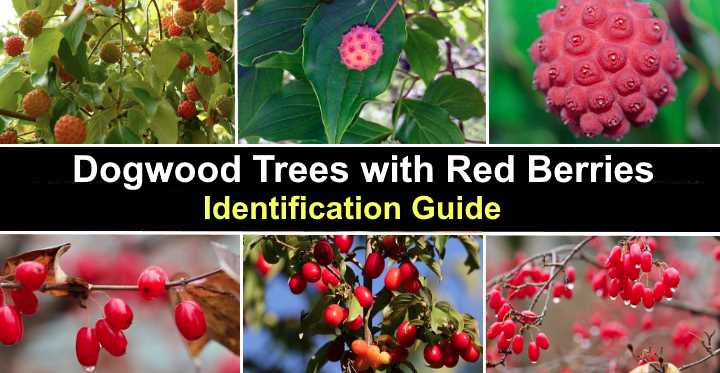
Dogwood trees with red berries are small to medium, beautiful, deciduous trees, some of which produce tasty fruit. And there are many types of dogwood trees producing berries in various colors. Most dogwood trees have white, star-shaped flowers, lance-shaped leaves, and peeling bark.
The most common dogwood tree with red berries is the kousa dogwood. This fruit-producing tree is prized for its attractive shape, edible red globe-shaped berries, and spectacular red and purple fall foliage.
Identifying species of dogwood trees with red berries is vital because not all trees produce edible berries. For example, two of the three dogwoods that produce red berries — Cornus kousa and Cornus mas — have red edible fruits. However, the red berries from Cornus florida are mildly poisonous.
Besides being small to medium trees, dogwoods are also a group of shrubs recognized by their bright red bark. These red-twig dogwood shrubs have excellent landscaping appeal, helping to add a splash of color to a winter landscape. However, small dogwood trees are just as useful in garden landscapes.
This article is a guide to identifying species of dogwood trees with red berries. Descriptions and pictures of the deciduous trees’ red fruit, leaves, and bark will help you recognize red-berry-producing dogwood trees in the landscape.
Are Dogwood Fruits Edible?
Red berries from two species of dogwood trees are edible. The popular kousa dogwood (Cornus kousa) and Cornelian cherry dogwood (Cornus mas) are tasty, sweet berries with hard seeds in the flesh. The native flowering dogwood (Cornus florida) produces shiny oval inedible berries growing in small clusters.
It is possible to tell the difference between edible red kousa dogwood berries and those from the Cornelian cherry and flowering dogwood species. Red kousa dogwood berries look like small round red balls with bumpy skin. On the other hand, berries from the other two species are shiny red oval drupes growing in small clusters.
What Do Dogwood Red Berries Taste Like?
The sweet, tasty red berries from the kousa dogwood tree taste like soursop or persimmon fruits. People describe the berry taste as a relatively sweet, creamy, rich flavor. Unfortunately, the small round globous red fruits also are packed with seeds, making them difficult to eat. In addition, the berries have a thick rind with a bitter taste.
Common Types of Dogwood Trees With Red Berries
The three common types of dogwood trees producing red berries are the kousa dogwood, Cornelian cherry dogwood, and the flowering dogwood tree. Dogwood trees are identified by their lanceolate leaves measuring 2.4” to 5.1” (6 – 13 cm) long. Flowering dogwood has the showiest blooms with large star-shaped white blossoms.
Types of Dogwood Trees with Red Berries
There are several types of dogwood trees producing berries. Two native North American native species produce red oval berries, and the Asian dogwood — kousa dogwood — has rounded, spherical red berries with bumps on the skin. Please read on to find out more about these beautiful flowering trees.
Kousa Dogwood (Cornus kousa)
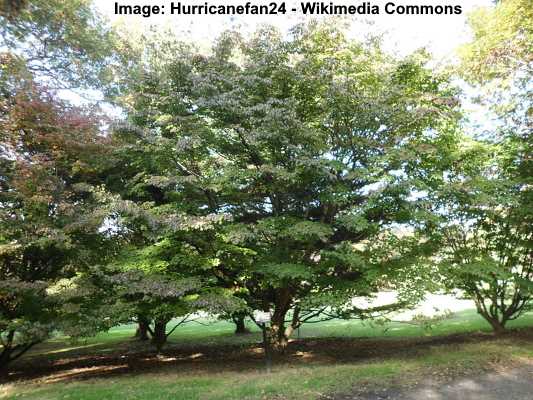
Kousa dogwood tree (Cornus kousa)
The popular kousa dogwood is a small deciduous tree with spectacular white blossoms, globose pink to red berries, and a vase-shaped crown. The landscaping appeal of the kousa dogwood is thanks to its dark green foliage turning red in the fall, a canopy of layered branches, and mottled tan and gray bark.
Kousa dogwood trees grow 15 – 30 ft. (4 – 9 m) tall and wide. Compared to native dogwoods, the kousa dogwood has a more upright habit and flowers later than the other species. The tree is identified by its vase habit that becomes rounded with age.
The kousa dogwood thrives in USDA zones 5 through 8. You should plant the dogwood tree in full sun to partial shade and ensure the ground is organically rich and well-draining. Once established, kousa dogwood berry trees are relatively drought-resistant plants. However, the deciduous tree requires average moisture, so you should water it to keep the soil consistently moist.
Native to eastern Asia, the kousa dogwood also goes by the names Chinese dogwood, Korean dogwood, and Japanese dogwood. However, the stunning multi-stemmed tree is cultivated throughout the United States as a small ornamental landscaping tree.
Kousa Dogwood Berries
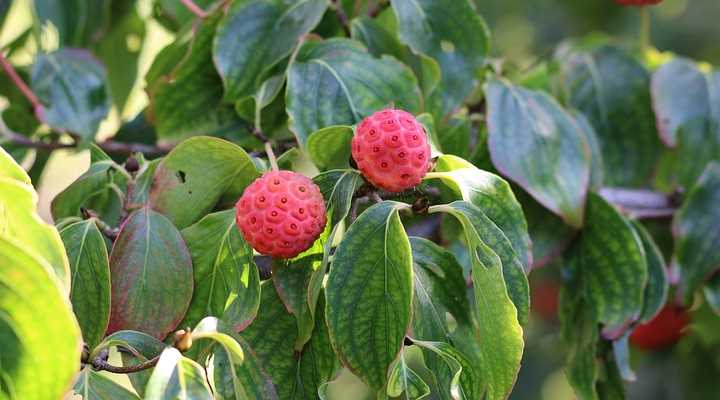
Kousa dogwood fruit
The red berries on a Kousa tree are edible fruits, globose shaped with tough, rough outer skin and small bumps. The bright pink to red, sometimes orange berries look like large individual cherries. The ball-shaped fruits dangle at the end of a long, slender petiole. The flesh has a soft, slippery, custard-like consistency.
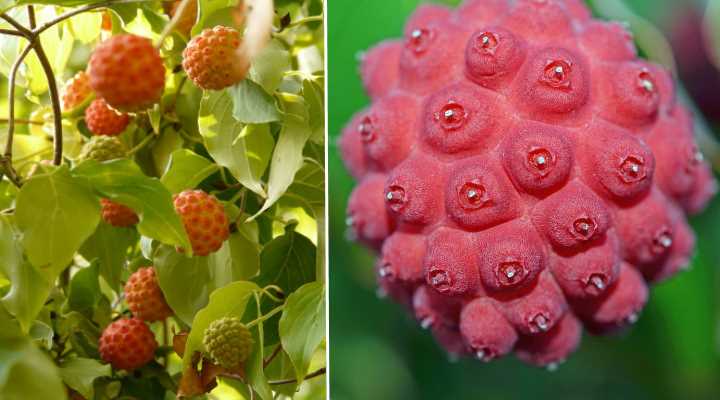
Kousa dogwood berries measure 0.78” to 1.1” (2 – 3 cm) across. Some people describe the look of a kousa dogwood berry as a round lychee.
Red dogwood berries are a type of aggregate fruit like blackberries or raspberries. However, the compound berries look like single round fruit. The berries appear in summer after flowering and persist on the tree until the fall.
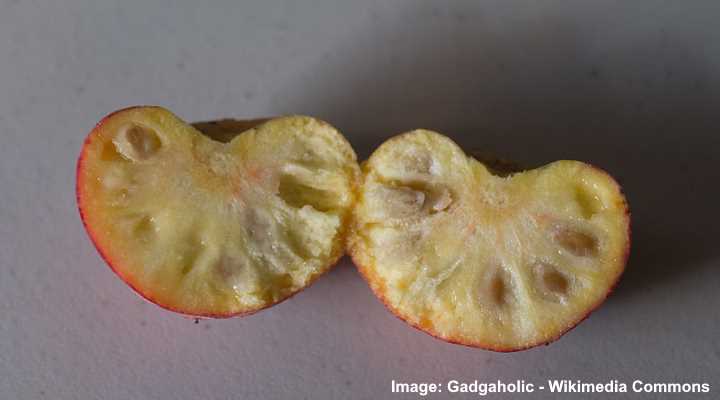
Cornus kousa fruit cut in hal
Kousa Dogwood Leaves
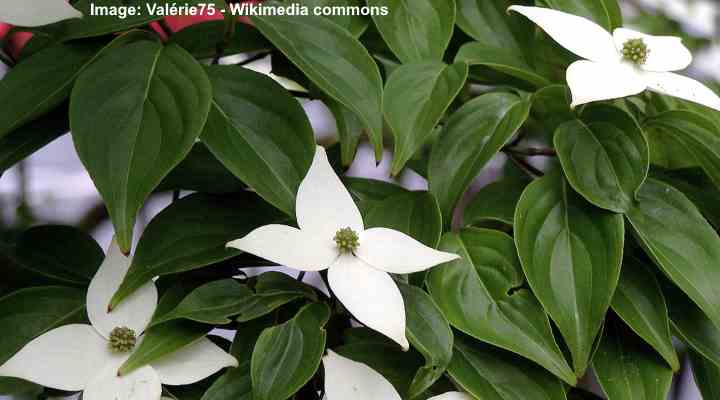
Kousa dogwood leaves and flowers
Leaves on a kousa dogwood tree are shiny, dark green simple oval to lance-shaped leaves growing oppositely on branches. The kousa dogwood leaves measure 1.5” to 4” (4 – 10 cm) long and grow densely on branches. The thick foliage on Chinese dogwood trees provides excellent shade and shelter from spring through fall.
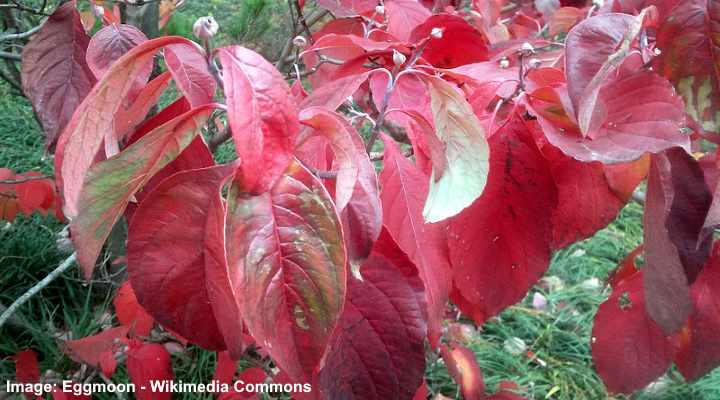
Kousa dogwood leaves in autumn
Kousa dogwood trees turn spectacular colorful shades in the fall. The deciduous dogwood leaves turn burgundy red before taking on deeper shades of purple. In addition, some ornamental dogwood trees have variegated leaves that add to their decorative appeal.
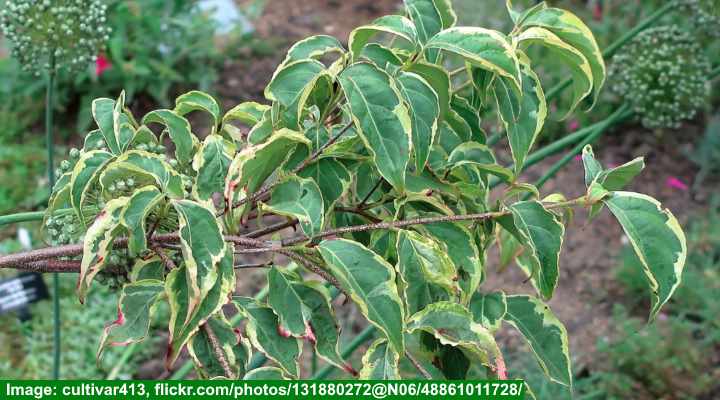
Kousa dogwood ‘Kristin Lipka’s Variegated Weeper’ has green and creamy-yellow leaves
Kousa Dogwood Bark
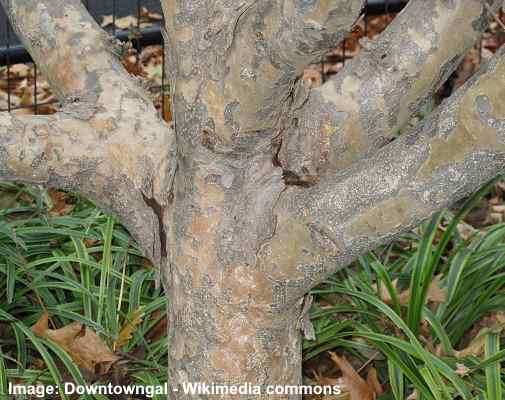
Kousa dogwood bark
The patchy gray, pink, and beige bark on kousa dogwood trees is one of the tree’s easily identifiable features. The interesting bark is light to dark grayish brown, which exfoliates as the tree matures, leaving behind patches of reddish-brown and tan. This attractive smooth bark gives mature trees a camouflage look.
Kousa Dogwood Flowers
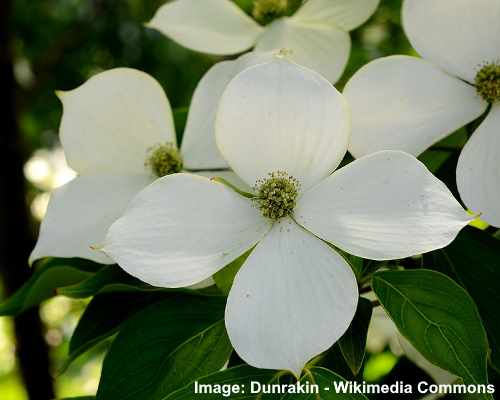
A close up picture of Kousa dogwood flowers
Flowers on kousa dogwood trees bloom in spring. Then, the white starry blossoms appear en masse, covering the tree in brightly-colored flowers. Kousa dogwood flowers are actually small green flowers surrounded by four, pointed, snow-white bracts. The flowers persist through spring until early summer.
Kousa dogwood flowers appear on branches long after the tree leafs out. The blooming time is typically in May — a month after other dogwoods, which usually bloom in April.
Kousa Dogwood Seeds
Seeds in red kousa dogwood berries are around 0.25” (0.6 cm) long. The seeds are exceedingly hard, with an oval shape, looking like a long grape seed. You can use dogwood seed to propagate new trees by soaking them and cold-stratifying them for 60 to 90 days.
Kousa Dogwood Growth Rate
Kousa dogwood is a relatively slow-growing tree that increases in height between 12” and 24” (30 – 60 cm) annually. The trees eventually reach a mature height of 15 to 25 ft. (4.5 – 7.6 m). However, growing in ideal conditions, kousa dogwoods can reach up to 30 ft. (9 m).
Where to Grow Kousa Dogwood Tree
You can plant a kousa dogwood tree in acidic, nutrient-rich soil with good drainage. Ideally, the dogwood trees thrive in full sun or part shade and can tolerate six hours of direct sunlight daily. In the hottest climates, some shade during the afternoon will keep the tree healthy.
How to Identify Kousa Dogwood Tree
The easiest way to identify the kousa dogwood is by its distinctive mottled bark and red fruits. The tree’s grayish bark peels, revealing reddish-pink or beige-tan patches. Additionally, kousa dogwoods produce red berries 0.78” to 1.1” (2 – 3 cm) across. Finally, the trees have white flowers and deep green lanceolate leaves turning red in the fall.
Flowering Dogwood (Cornus florida)
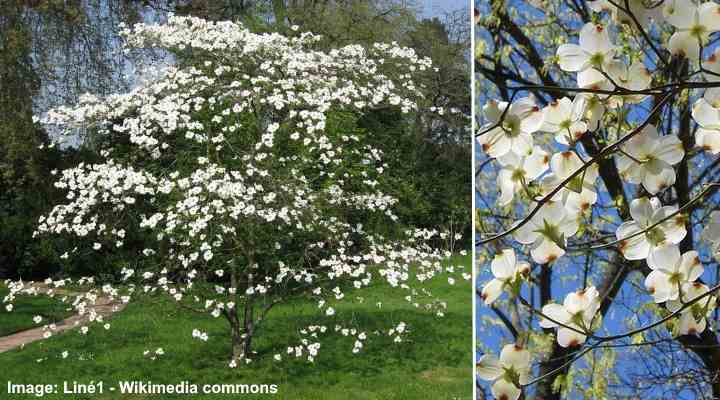
Flowering dogwood (Cornus florida) tree and flowers
Flowering dogwood is a spectacular landscaping tree with a rounded to flattened crown, pure white star-shaped flower-like bracts, and clusters of orangey-red fruit. Flowering dogwoods have tremendous ornamental appeal in garden landscapes. The tree’s dark green foliage, white flowers, red berries, and attractive shape add to its visual appeal.
Flowering dogwood trees grow 15 to 30 ft. (4.5 – 9 m) tall and wide. It is recognized by its pyramidal crown that flattens as it matures. This dogwood species is regarded as a tree with a medium growth rate and grows about 16 ft. (5 m) in ten years. Flowering dogwood’s life-span is 80 years.
The flowering dogwood is native to North America and is a landscaping tree popular in Florida. The flowers are also the state flower of North Carolina. The landscaping tree is hardy in USDA zones 5 through 9.
Many gardeners consider flowering dogwood as one of the most spectacular landscaping trees. The visual appeal of flowering dogwoods is from its alligator skin-like bark, clusters of glistening fruits, and shades of scarlet and purple in the fall. These features of flowering dogwoods give the trees four-season visual appeal.
Flowering dogwood leaves
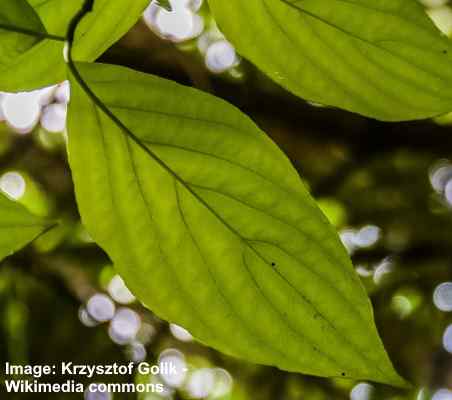
Flowering dogwood leaves
The leaves on the dogwood are ovate-shaped, measuring 3” to 6” (7.5 – 15 cm) long. The smooth leaves have characteristic veins that bend up toward the tip. And they typically have a slightly wavy margin. However, it can be difficult to identify dogwood trees by their leaves alone.
Flowering dogwood berries
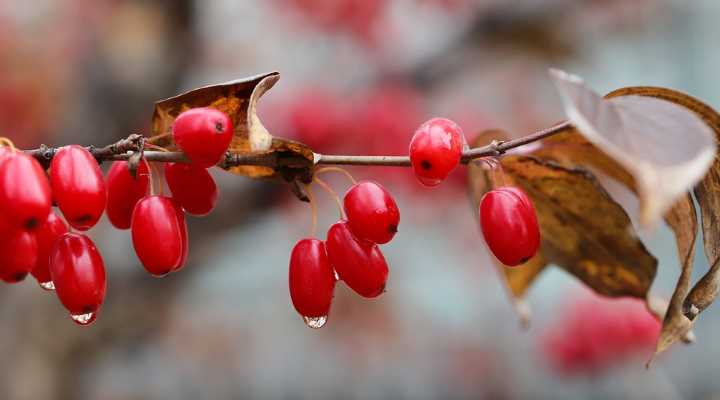
Flowering dogwood berries
The red berries on flowering dogwood trees are not edible but have a bitter, terrible taste. The berries are bright red with an oval shape and grow in small clusters on the tree. Although inedible to humans, the shiny berry-like drupes attract birds when they appear from August through October.
Poisonous flowering dogwood red berries look different from kousa dogwood berries. The drupes are red and shiny with smooth skin. This feature is unlike edible kousa dogwood fruits that are round with leathery skin covered in bumps.
Flowering dogwood bark
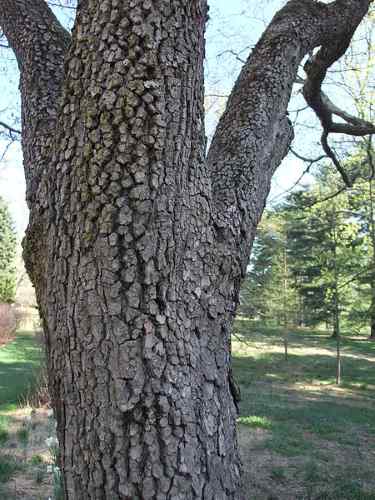
Flowering dogwood bark
Apart from its red berries, the bark is the other identifying feature of flowering dogwood trees. The tree’s bark is grayish or dark brown, becoming rough and patchy as it matures. Looking at pictures of the scaly bark, it appears broken into small blocks on the tree.
Cornelian Cherry Dogwood (Cornus mas)
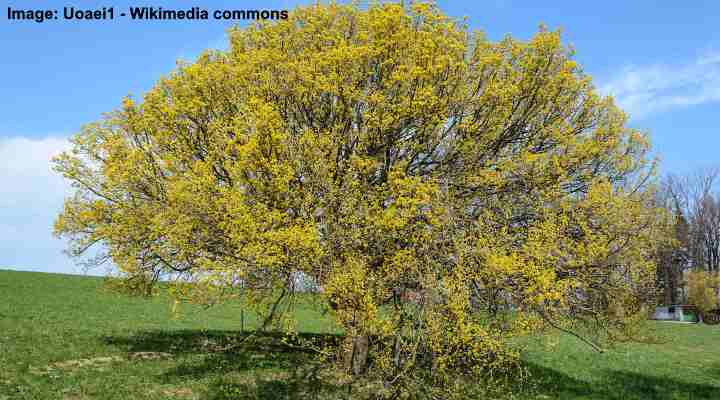
Cornelian cherry dogwood tree (Cornus mas)
The Cornelian cherry dogwood is a medium sized deciduous landscaping tree. This dogwood species is identified by its yellow, four-petalled flowers growing in dense clusters, shiny, oblong red fruits, and large leaves growing oppositely on branches. Mature Cornelian cherry dogwood trees have scaly, exfoliating bark.
Cornelian cherry dogwood trees grow 16 to 40 ft. (5 – 12 m) tall and have a dense growth habit. They thrive in USDA zones 5 through 8. The trees perform best in full sun or partial shade, growing in organically-rich, well-drained soil.
To grow the shrub-like tree as a single-stemmed specimen, you’ll need to remove suckers regularly to prevent producing a dogwood shrub.
Uses in the landscape for Cornelian cherry dogwoods include a specimen tree, lawn tree, or shade tree. Dwarf varieties of these dogwoods don’t grow over 3 ft. (1 m) tall. Therefore, the small shrub-like trees are ideal for foundation planting, shrub borders, privacy screens, or flowering hedgerows.
The multi-stemmed tree has plenty of visual appeal in a garden landscape due to its four-season interest. Bright yellow colors appear in late winter or early spring, followed by densely growing green foliage, then clusters of small red cherry-like drupes. These features make the Cornelian cherry dogwood one of the most popular flowering dogwoods.
Cornelian cherry dogwood tree leaves
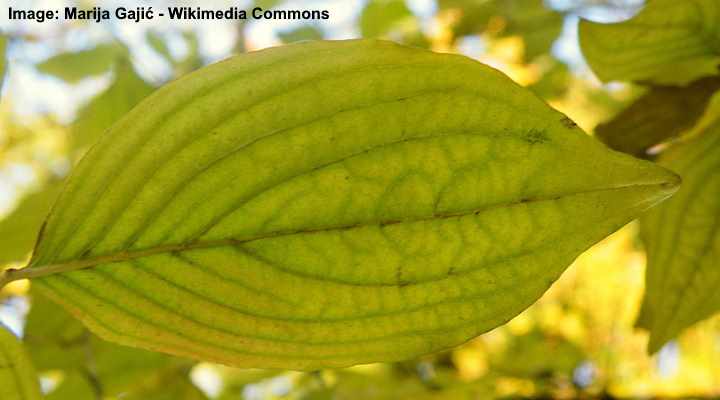
Cornelian cherry dogwood leaf
Leaves on Cornelian cherry dogwood trees are described as simple leaves with an elliptical or ovate shape and glossy appearance. The pointed leaves turn up at the margins. The dogwood leaves measure 1.5” to 4” (4 – 10 cm) long and 0.78” to 1.5” (2 – 4 cm) wide. In the fall, they turn shades of green and yellow with red and purple patches.
Cornelian cherry dogwood tree flowers
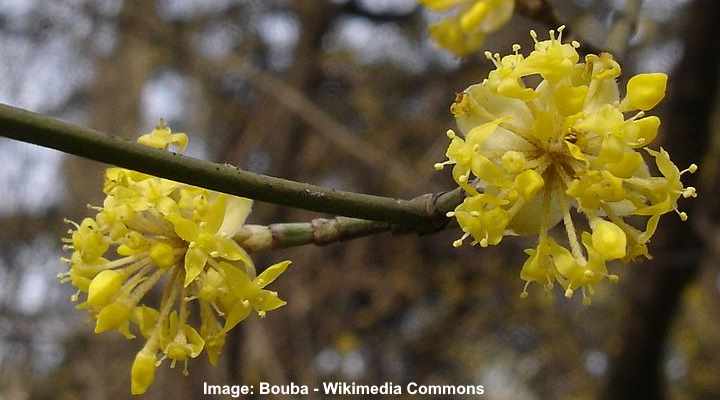
Cornelian cherry dogwood flowers
Flowers on Cornelian cherry dogwood trees are bright, golden-yellow showy clusters. The tiny yellow flowers bloom in late March or early April. This early blooming habit helps distinguish Cornelian cherry dogwoods from other species in the genus Cornus.
Cornelian cherry dogwood tree bark
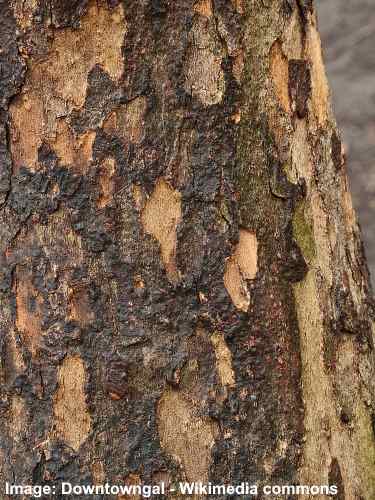
Cornelian cherry dogwood bark
The bark on Cornelian cherry dogwoods is brownish, developing a rough, flaky texture, resulting in the tree’s shaggy appearance. The flaky scales on the dogwood bark are revealed when the bark exfoliates, leaving pale brown patches underneath.
Cornelian cherry dogwood tree berries
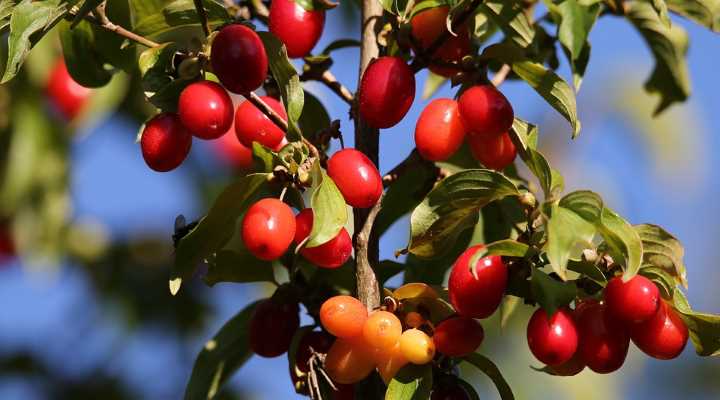
Cornelian cherry dogwood berry-like fruit
Berries on Cornelian cherry dogwood trees are edible olive-shaped drupes. The tree’s fruit is bright red and appears in clusters in mid-summer. Although people call them berries, they are drupes — fleshy fruits with a single stone. The berry-like drupes are dark red when ready to eat.
Although edible, it’s easy to confuse edible Cornelian cherry dogwood red berries with poisonous fruits from the Cornus florida species. Both types of berries are shiny, bright red oblong fruits. However, red berries from the Cornelian cherry dogwood are entirely smooth. In contrast, the flowering dogwood berries have a woody growth on one end.
Distinguishing between kousa dogwood berries and flowering dogwood and Cornelian cherry dogwood berries is relatively simple. Red kousa dogwood berries are round and bumpy — not smooth and oblong — and don’t have shiny skin.
Related articles:
- Dogwood Trees and Shrubs – Identification
- Red Berries That Grow on Trees or Shrubs
- Berries That Grow On Trees
